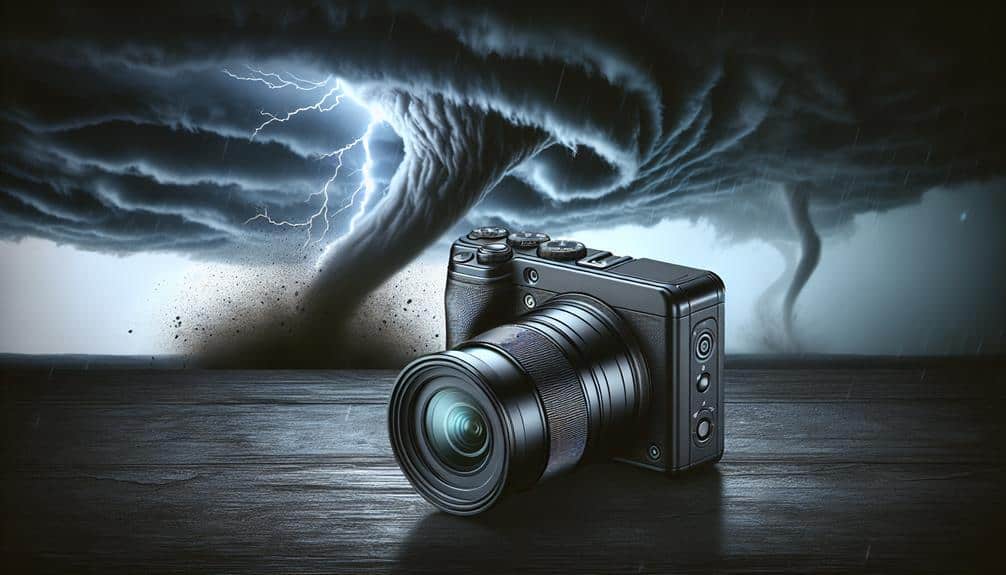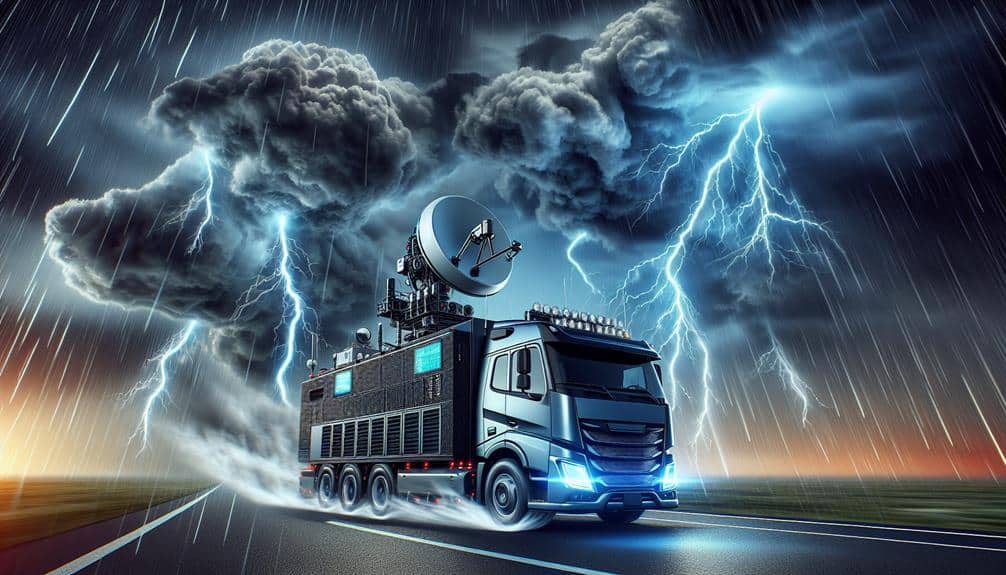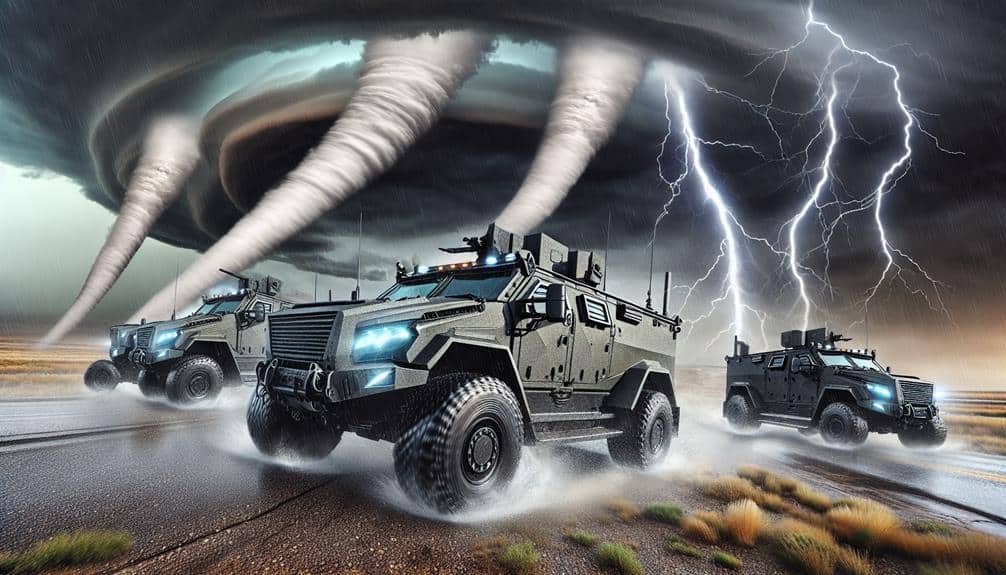When chasing tornadoes, we need a durable storm chaser vehicle with reinforced frames, heavy-duty tires, and advanced navigation. High-quality weather radios with NOAA bands and SAME technology give us critical alerts. We wear protective clothing made from high-tenacity nylon, ensuring waterproof, moisture-wicking, and impact-resistant properties. Waterproof GPS devices with emergency communication verify our location, and advanced digital cameras capture high-resolution storm data. Rugged laptops with powerful hardware and weatherproof power supplies keep our tech operational under extreme conditions. By focusing on these weatherproof essentials, we can track storms safely and efficiently, enhancing our storm-chasing endeavors. Want specifics on each?
Key Points
- Weather Radios: Real-time updates with NOAA weather bands, rechargeable batteries, and manual charging options for continuous severe weather alerts.
- Protective Clothing: Durable, waterproof storm-resistant gear with moisture-wicking, insulation, and impact resistance for maximum safety and mobility.
- GPS Devices: Waterproof, durable, and equipped with emergency communication and advanced tracking technology to maintain connectivity in severe conditions.
- Digital Cameras: High-resolution, weatherproof cameras with HDR capabilities and sturdy tripods for capturing storm structures in harsh weather.
Durable Storm Chaser Vehicles
When choosing robust storm chaser vehicles, we prioritize models with reinforced frames, versatile off-road capabilities, and high torque engines to withstand extreme weather conditions. These specifications guarantee our vehicles can navigate the demanding terrain and harsh environments common in storm tracking.
Reinforced frames are crucial; they provide the structural strength necessary to resist the strong winds and debris encountered during tornadoes.
Our focus on versatile off-road capabilities ensures that storm chaser vehicles can travel through muddy fields, rugged backroads, and flooded areas without getting stuck. This maneuverability is vital for prompt emergency response and efficient data collection.
We require high torque engines because they produce the essential power to drive through extreme conditions, guaranteeing our vehicles remain operational even when conditions are challenging.
Moreover, we outfit our vehicles with sturdy equipment, such as heavy-duty tires and strong suspension systems, to manage the physical pressures of storm chasing. Advanced navigation systems and real-time weather data integration are also crucial, enabling us to make informed decisions on the move.
High-Quality Weather Radios
High-quality weather radios are vital tools for storm chasers, providing real-time updates on severe weather conditions through precise and reliable communication channels. These devices are essential for maintaining emergency communication, especially when cell signals fail or internet access is unavailable. Equipped with NOAA (National Oceanic and Atmospheric Administration) weather bands, these radios deliver timely alerts on tornado warnings, severe thunderstorms, and flash floods.
We prioritize models with Specific Area Message Encoding (SAME) technology, which allows us to program alerts for specific geographic areas. This feature is essential for avoiding false alarms and focusing on immediate threats.
Battery life is another significant factor; we often choose units with both rechargeable batteries and manual charging options, like hand cranks or solar panels, guaranteeing continuous operation even during extended chases.
Safety precautions are paramount, and high-quality weather radios enhance our situational awareness. Many models include additional features like LED flashlights and USB ports for charging other devices, making them versatile tools in the field.
When unpredictable weather conditions threaten our freedom to chase, having a dependable weather radio ensures we stay informed and prepared, allowing us to make swift, informed decisions and maximize our safety.
Reinforced Protective Clothing
When selecting reinforced protective clothing, we must prioritize durable materials like Kevlar or Nomex that can withstand debris impact.
These garments often include enhanced safety features such as integrated padding and high-visibility strips.
Durable Material Selection
Selecting durable materials for reinforced protective clothing is crucial for ensuring safety and resilience during tornado chasing. We prioritize materials that integrate advanced waterproof technology to keep us dry and comfortable, even in the most torrential downpours. This technology not only prevents water intrusion but also enhances the longevity in the field, allowing us to stay focused on tracking severe weather without worrying about gear failure.
Resilient fabrics are essential when considering storm-resistant gear. High-tenacity nylon or polyester with a durable water repellent (DWR) coating provides a robust outer shell that can withstand the abrasive elements encountered during tornado chasing. These materials are engineered to resist tearing and punctures, ensuring our protective clothing remains intact despite flying debris and high winds.
Moreover, we look for multi-layered constructions where each layer serves a specific function—whether it's moisture-wicking, insulation, or impact resistance. Such designs offer thorough protection without compromising mobility, which is essential for rapid response and agility in the field.
Enhanced Safety Features
To maximize our protection during tornado chasing, we integrate advanced safety features like reinforced seams, high-visibility reflective strips, and impact-resistant padding into our protective clothing. These elements are essential for enduring the volatile conditions we face.
Reinforced seams guarantee our gear remains intact against fierce winds and flying debris, while high-visibility reflective strips enhance our visibility in low-light scenarios, a common occurrence during storm activity.
Impact-resistant padding is strategically placed to shield crucial areas from potential injuries. This padding uses advanced materials, tested for maximum durability and shock absorption.
Our safety equipment isn't just about personal protection; it also includes emergency communication devices. These are often embedded within our gear to maintain connectivity when traditional channels fail. For instance, GPS trackers and two-way radios ensure we stay in touch with our team, providing real-time updates and alerts, which are essential for coordinated efforts and timely evacuations.
The freedom to chase storms doesn't come without responsibility. By incorporating these enhanced safety features into our protective clothing, we increase our chances of staying safe and making it back to tell the tale. Our quest for thrill is balanced by a commitment to safety and preparedness.
Waterproof GPS Devices
Dependable guidance is essential for tornado chasers, and waterproof GPS devices guarantee functionality in harsh weather conditions. When we're out in the field, the rugged environment can easily compromise our gear. Waterproof GPS units not only withstand torrential rain but also assure we don't lose our way when it matters most.
A top-tier waterproof GPS offers several critical features:
- Emergency Communication: Many devices are equipped with built-in emergency communication capabilities, allowing us to send distress signals or location coordinates when cellular networks are down.
- Tracking Technology: Advanced tracking technology assures precise and real-time location updates, critical when navigating rapidly changing storm paths.
- Durability and Battery Life: These devices are designed to endure extreme conditions and offer extended battery life, often lasting up to 20 hours on a single charge.
We can't afford to compromise on navigation equipment. With these GPS devices, we can confidently track tornadoes, update our position, and maintain communication even in the worst weather.
These tools grant us the freedom to chase storms without fearing equipment failure, keeping us safe and informed in the most challenging environments.
Advanced Digital Cameras

In the field of tornado chasing, advanced digital cameras are essential for capturing high-resolution images and videos, providing invaluable data for analysis and research. We rely on the superior image quality these cameras deliver, necessary for studying storm structures and behavior. High dynamic range (HDR) capabilities allow us to capture both the bright lightning and dark storm clouds in a single frame.
Choosing the right camera accessories is equally significant. A sturdy tripod guarantees stability in high winds, while a remote shutter release helps us avoid camera shake. Weatherproof housing protects our equipment from the harsh elements we often encounter.
Lens selection is another vital aspect. Wide-angle lenses enable us to capture the vastness of the storm, while telephoto lenses let's zoom in on specific features like wall clouds or tornado funnels.
Mastering various photography techniques, such as long-exposure and time-lapse, can reveal details about storm dynamics that aren't visible to the naked eye.
Rugged Laptop Computers
When we're out in the field, rugged laptop computers serve as our command center, allowing us to process real-time data, analyze storm patterns, and communicate with our team despite the harshest conditions. These devices are engineered to withstand the elements, ensuring that we remain operational no matter what challenges nature presents.
Key features of our rugged laptop computers include:
- Impact Resistant: Built to endure drops, shocks, and vibrations, these laptops can handle the demands of storm chasing. Their reinforced casings and durable internal components guarantee they keep running smoothly even in the most turbulent environments.
- All Terrain Capabilities: Whether we're traversing muddy backroads or setting up in a torrential downpour, these laptops are designed to operate in diverse terrains. Their sealed keyboards and ports prevent dust and water ingress, maintaining functionality in unpredictable conditions.
- High-Performance Hardware: Equipped with powerful processors, ample RAM, and advanced graphical capabilities, these laptops allow us to run complex meteorological software and model storm dynamics with precision.
Weatherproof Power Supplies

When chasing tornadoes, we can't overlook the significance of reliable, weatherproof power supplies. Portable battery packs, solar charging panels, and wind-up generators are essential for maintaining our equipment's functionality in extreme conditions.
These solutions guarantee continuous power availability, reducing the risk of equipment failure during critical moments.
Portable Battery Packs
Reliable power sources are fundamental for tornado chasers, and weather-resistant portable battery packs provide the necessary resilience and capacity to keep equipment running in harsh conditions. We need devices that won't fail under pressure, and the right battery pack can make all the difference.
A good portable battery pack should combine a lightweight design with long-lasting power. We often find ourselves on the move, and lugging around heavy gear isn't practical. A lightweight design guarantees we can carry other essential equipment without being weighed down. Equally important is the battery's endurance; we can't afford to run out of power while tracking a storm.
Fast charging and multiple ports are also vital features. When we're in the field, time is of the essence. Fast charging capabilities mean less downtime and more time focused on the chase. Multiple ports allow us to keep various devices charged simultaneously, from cameras to communication tools.
Here's what we should look for in a portable battery pack:
- Weather-resistant construction for durability in extreme conditions.
- High capacity to maintain long-lasting power.
- Lightweight design for ease of transport.
Solar Charging Panels
In addition to portable battery packs, solar charging panels offer a sustainable and weatherproof solution to keep our gear powered in the field. Solar panels convert sunlight into electrical energy, making them invaluable when we're chasing tornadoes in remote locations. These panels are designed to withstand harsh weather conditions, guaranteeing they remain functional even when the skies are less than friendly.
Having reliable power is essential for our emergency communication devices. In remote areas where grid power is non-existent, solar charging panels provide an essential lifeline. High-efficiency monocrystalline panels, with conversion rates exceeding 20%, ensure we get the most power from each ray of sunlight. Portable models, such as foldable or rollable panels, offer flexibility and ease of transport, allowing us to set up and charge on the go.
When selecting solar charging panels, we prioritize durability, power output, and compatibility with our existing devices. Some panels come with integrated USB ports and 12V outputs, making them versatile for charging everything from smartphones to satellite phones.
Wind-Up Generators
Among the important tools in our tornado chasing gear, wind-up generators provide a dependable and weatherproof source of power, ensuring our equipment remains operational regardless of the conditions. These devices are vital for maintaining emergency lighting and emergency communication systems when traditional power sources fail.
Wind-up generators offer several advantages:
- Reliability: Unlike solar panels that depend on sunlight, wind-up generators can be manually powered, guaranteeing a continuous energy supply even during night chases.
- Weatherproof Design: Built to withstand extreme weather conditions, these generators ensure that our gear remains functional in the face of heavy rain, strong winds, and debris.
- Versatility: They can charge a wide range of devices, from radios and flashlights to GPS units, ensuring we've all necessary tools at our disposal.
Technical specifications of top models include robust construction materials, such as impact-resistant plastic and rubberized seals, which prevent water ingress. High-efficiency dynamo systems convert kinetic energy into electrical energy, optimizing battery life.
For us, freedom means being able to rely on our gear, no matter the circumstances. Wind-up generators aren't just a backup; they're an important part of our strategy to stay connected, lit, and ready for anything nature throws our way.
Frequently Asked Questions
What Are the Best Apps for Real-Time Weather Updates While Tornado Chasing?
We recommend apps like RadarScope for precise storm tracking and radar analysis, and Weather Underground for accurate real-time updates. MyRadar excels in GPS tracking, while Zello facilitates emergency communication. They guarantee we chase safely and effectively.
How Can I Safely Store and Transport Sensitive Equipment During a Storm Chase?
To guarantee equipment protection and storage, we use cushioned, weather-resistant cases. For weather-resistant transportation, we secure gear in waterproof, shock-absorbent containers. Safety is paramount; always double-check seals and fastenings before setting out on the storm chase.
Are There Specific Insurance Policies Recommended for Storm Chasers?
We recommend storm chasers get insurance coverage that includes liability protection for extreme weather. Policies should cover equipment damage, injury, and third-party claims. It's important to review terms to guarantee thorough protection during unpredictable storm conditions.
How Do I Stay Connected to the Internet in Remote Storm-Prone Areas?
Imagine we're sailors steering through stormy seas; satellite communication is our lighthouse. It guarantees we stay connected to emergency contacts, even in distant, storm-prone areas, providing a beacon of connectivity amidst the chaos.
What First Aid Supplies Should Be Included in a Tornado Chasing Kit?
We need to include emergency medications for allergies and chronic conditions, along with wound care supplies like antiseptics, bandages, and gauze. This guarantees we're prepared for immediate medical needs while chasing tornadoes in remote areas.

